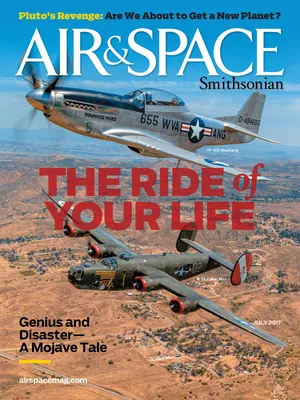Flight of the Airsick Lobsters
Crustaceans don’t do well in turbulence.
/https://tf-cmsv2-smithsonianmag-media.s3.amazonaws.com/filer/21/38/213891f8-c648-49a4-bf13-e83aa7df04bd/18a_jj2017_finaldavidclarkart_live.jpg)
Naval aviation is famous for its many traditions, and planners obviously took some of them into account when they built an air station on the coast in Brunswick, Maine, where live chicken lobsters were plentiful and cheap.
In the fall of 1958, I flew Lockheed P2V-5 Neptunes in a Navy anti-submarine patrol squadron based at Naval Air Station Chincoteague, Virginia. I volunteered to fly a “training flight” to NAS Brunswick, and of course since we happened to be up there, we intended to return with 150 to 200 chicken lobsters, to be divided among the pilots.
We took off around noon with a minimum crew: copilot, plane captain, radio operator, and two crew members along for the ride. It was a perfect fall day, with unlimited visibility all the way up, although storms were forecast for the return flight that afternoon. About 45 minutes out of Brunswick we called the tower and requested they contact the local lobster supplier with our order. We landed, taxied to the operations area, shut down, and found eight cardboard cartons of live lobsters waiting, which we loaded into the back of the P2V.
Moderate storms were moving rapidly into the area from the west, so we filed an instrument flight plan for the return flight to Chincoteague, which would put us at the mercy of the air traffic controllers of New York Center.
We took off, and within 20 minutes were in solid overcast, flying on instruments, and enduring a fair amount of turbulence. As we neared the coast of Connecticut, New York Center called and asked us to climb to 12,000 feet to avoid the heavy air traffic of New York City’s airports. We had no oxygen aboard, so we advised Center we could go no higher than 10,000 feet, which didn’t make the controller happy—we couldn’t climb above the air traffic—so he put us in a holding pattern over the extreme east end of Long Island and advised us we’d be there for around 40 minutes until he could clear a path. So there we were, circling at 8,000 feet in heavy turbulence, with six people and 200 presumably airsick lobsters on board.
After 20 minutes or so, one of the crew members from the back of the airplane got on the intercom with bad news: In the turbulence, one of the lobster cartons was upended, and 25 lobsters were now scuttling around the back of the airplane. He went on to say that since it was very warm back there, they had opened the small camera hatch in the floor for ventilation, and a dozen of the little guys had escaped out the open hatch.
I hoped the little lobster-bombs had fallen back into the ocean rather than on the residents and buildings of Riverhead, Long Island. Worse still was the potential to hit the other airplanes that may have been below us in the same holding pattern—we were not eager to take responsibility for the first airborne crustacean strike. Although lobsters falling from the clouds would undoubtedly puzzle people at first, even cursory investigation would identify our aircraft as the obvious source. Accidentally dropping wriggling safety hazards could not only end our careers but threaten the entire Navy “training flight” tradition. The last people we wanted to hear from were the air traffic controllers, but just then New York Center called to release us from the holding pattern ahead of schedule, and cleared us the rest of the way to Chincoteague. Fortunately there was no mention of lobsters.
The rest of the flight south went according to plan, and although we landed late, all hands were there to claim their lobsters (adjustments were made to compensate for the skydiving dozen). I never made another lobster run, but others in the squadron did, and fine aviators that they were, they made sure to learn from my experience: After the lobsters boarded, hatches always remained closed.
Thus a naval aviation tradition was saved, and new generations of anti-submarine patrol crews have followed my P2V experience. Though NAS Chincoteague closed in 1959 and Brunswick in 2011, I hope the lobster tradition continues somewhere today.
